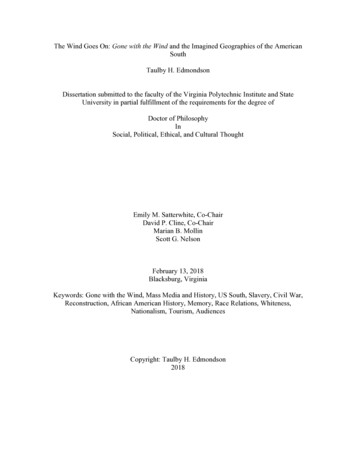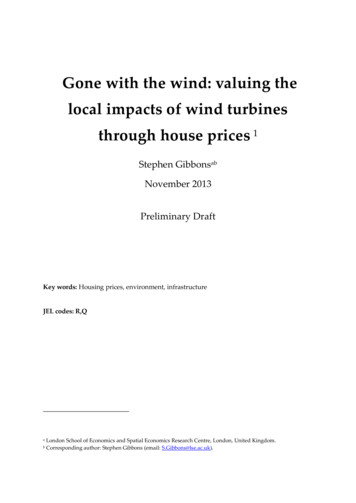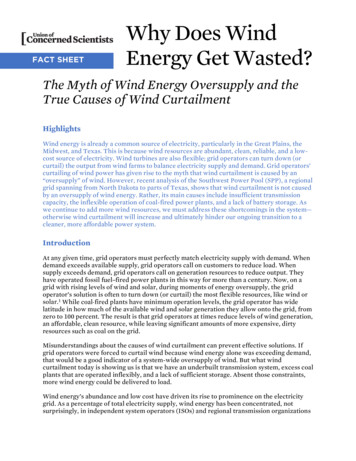
Transcription
The Wind Goes On: Gone with the Wind and the Imagined Geographies of the AmericanSouthTaulby H. EdmondsonDissertation submitted to the faculty of the Virginia Polytechnic Institute and StateUniversity in partial fulfillment of the requirements for the degree ofDoctor of PhilosophyInSocial, Political, Ethical, and Cultural ThoughtEmily M. Satterwhite, Co-ChairDavid P. Cline, Co-ChairMarian B. MollinScott G. NelsonFebruary 13, 2018Blacksburg, VirginiaKeywords: Gone with the Wind, Mass Media and History, US South, Slavery, Civil War,Reconstruction, African American History, Memory, Race Relations, Whiteness,Nationalism, Tourism, AudiencesCopyright: Taulby H. Edmondson2018
The Wind Goes On: Gone with the Wind and the Imagined Geographies of the AmericanSouthTaulby H. EdmondsonABSTRACTPublished in 1936, Margaret Mitchell’s Gone with the Wind achieved massive literarysuccess before being adapted into a motion picture of the same name in 1939. The noveland film have amassed numerous accolades, inspired frequent reissues, and sustainedmass popularity. This dissertation analyzes evidence of audience reception in order toassess the effects of Gone with the Wind’s version of Lost Cause collective memory onthe construction of the Old South, Civil War, and Lost Cause in the Americanimagination from 1936 to 2016. By utilizing the concept of prosthetic memory inconjunction with older, still-existing forms of collective cultural memory, Gone with theWind is framed as a newly theorized mass cultural phenomenon that perpetuates LostCause historical narratives by reaching those who not only identify closely with it, butalso by informing what nonidentifying consumers seeking historical authenticity thinkabout the Old South and Civil War. In so doing, this dissertation argues that Gone withthe Wind is both an artifact of the Lost Cause collective memory that it, more thananything else, legitimized in the twentieth century and a multi-faceted site where memoryof the South and Civil War is still created.My research is grounded in the field of memory studies, in particular the work of PierreNora, Eric Hobsbawn, Andreas Huyssen, Michael Kammen, and Alison Landsberg. Inchapter one, I track the reception of Gone with the Wind among white Americanaudiences and define the phenomenon as rooted in Benedict Anderson’s conception ofthe nation. I further argue that Gone with the Wind’s Lost Causism provided whitenational subjects with a collective memory of slavery and the Civil War that made senseof continuing racial tensions during Jim Crow and justified white resistance to AfricanAmerican equality. Gone with the Wind, in other words, reconciled the lingeringideological divisions between white northerners and southerners who then were moreconcerned with protecting white supremacy.In chapter two and three, I analyze Gone with the Wind’s continuing popularitythroughout the twentieth century and its significant influence on other sites of nationalmemory. Chapter four uses contemporary user reviews of Gone with the Wind DVD andBlu-ray collector’s editions to reveal that the phenomenon remains popular.Throughout this study I analyze the history of black resistance to the Gone with the Windphenomenon. For African Americans, Gone with the Wind’s Lost Causism has alwaysbeen understood as justification for racism, imbuing the white national conscious with amythological history of slavery and black inferiority. As I argue, black protestors to Gonewith the Wind were correct, as the phenomenon has always resonated most duringmoments of increased racial tension such as during the civil rights era and following theCharleston Church Massacre in 2015.
The Wind Goes On: Gone with the Wind and the Imagined Geographies of the AmericanSouthTaulby H. EdmondsonPUBLIC ABSTRACTThis study analyzes the continuing popularity of the popular culture phenomenon Gonewith the Wind, from its initial publication as a novel in 1936 to 2016. I first argue thatGone with the Wind is an artifact of the Lost Cause, which is defined as an amalgamationof myths about southern history that relies on negative racial stereotypes, the venerationof the Confederacy, and the position that slavery was unimportant to the causes of theAmerican Civil War. The Lost Cause, as scholars have argued, has always been anideological justification for anti-black racism, particularly Jim Crow apartheid. As aproduct of this white supremacist mythology, I further argue that Gone with the Wind isnot merely an artifact of the Lost Cause, but its most powerful statement that definedwhat twentieth-century white Americans believed about southern history. As I reveal,Gone with the Wind resonated most among white audiences during periods of heightenedracial tensions, in particular during various points in the civil rights era and following the2015 Charleston Church Massacre. The Lost Cause remains a potent ideological forcethat underpins American white supremacy.In chapters one and two, I analyze Gone with the Wind’s popularity in the twentiethcentury using reviews by readers and viewers. I reveal that Gone with the Wind’spopularity was more due to its Lost Cause mythology rather than its narrative plot, andwas widely popular among white audiences across the North and the South. In chaptertwo, I also look at Gone with the Wind’s influence on later novels and films about theSouth before, in chapter three, highlighting how Gone with the Wind’s version of the LostCause became the primary historical narrative at sites of southern heritage tourism, inparticular plantation museums and Georgia’s Civil War sites. In chapter four, I highlightcontemporary user reviews of Gone with the Wind’s DVD and Blu-ray collector’seditions to reveal that its version of the Lost Cause remains a potent ideological influenceamong its fans.Throughout the chapter I also analyze the history of black resistance to the Gone with theWind phenomenon, including organized pickets during its original theatrical release andthe arson of a Gone with the Wind museum. For African Americans, Gone with theWind’s Lost Causism has always been understood as justification for racism, imbuing thewhite national conscious with a mythological history of slavery and anti-blackstereotypes.
AcknowledgementsResearch funding for this project was generously supplied by the Departments ofHistory and the Department of Religion and Culture at Virginia Tech. Thank you Mark,Linda, Brianna, Brian, and Karen for making it possible. Thank you Francois, Tamara,and the Alliance for Social, Political, Ethical, and Cultural Thought for supplyingnecessary funding for conference travel that greatly improved the quality of thisdissertation.Gratitude is also owed to the folks at the Whitney Plantation Museum, especiallyAshley Rogers, who took me on a private tour of the grounds. The work you all are doingis of tremendous importance.Many thanks are owed to my committee, especially Emily Satterwhite, who wasthe first reader, my mentor, and always dedicated to helping me through the project atevery turn, no matter if the issues were personal or professional. There is no way that Icould have completed this without you.Thank you David Cline for serving as co-chair and for guiding me through anindependent study that laid much of the theoretical groundwork for this project. Thankyou Marian Mollin and Scott Nelson for serving as committee members and for the workyou did as my former teachers. Your feedback and support has been invaluable.A great deal of gratitude is owed to my former mentors: Julia, Jack, and Judkin.This project is truly a culmination of my work at every academic level. Your influence isclear.Many thanks to my colleagues Jordan, Katie, Sascha, Francine, Jamie, Holly,Christian, Mario, Alex, Melissa, Eli, and Komal for your continued support, and forbeing there when I needed a break and a drink.Above all, I owe a great debt to my wife, Sheena, for her love, compassion, andunderstanding. This project could not have been completed otherwise. And, of course,thank you to Trigger, Ember, and Samson for the love, even if you weren’t always themost helpful.To my parents, Tony and Alice: thank you for always supporting me in myendeavors, and for instilling in me a love for history and education at an early age. Iwould not be where I am today without you. Words cannot express my gratitude.iv
Table of ContentsAcknowledgements .ivTable of Contents .v-viIntroduction 1Literature Review: The Lost Cause and Gone with the Wind .2Gone with the Wind: A Memory Phenomenon .20Methodological Note on Reception Analysis 28The Gone with the Wind Phenomenon: 1936-2016 .33African-American Resistance to the Gone with the Wind Phenomenon .48Chapter 1: Origins of—and Resistance to—the Gone with the Wind Phenomenon inMemory and Popular Culture, 1936-1940 .55Margaret Mitchell, Thomas Dixon, The Birth of a Nation, and Gone with theWind’s Racism .57White American and the Initial Reception of Gone with the Wind .66Building Resistance to the Production of Gone with the Wind . 80White Contemporaries’ Praise for David Selznick’s Gone with the Wind .89Radical African-American Resistance to David Selznick’s Gone with the Wind,1939-1940 .98Chapter 2: Gone with the Wind’s Pervasive Cultural Influence in Twentieth-centuryFiction and Film .115Record Popularity and Gone with the Wind as a Distinct Memory Phenomenon,1936-1942 . 116The Mass Commercialization of Gone with the Wind circa 1937-1942 .122Margaret Mitchell’s Impact on Southern Literature, 1937-1953 .125The Long Cinematic Shadow of Gone with the Wind, 1938-2003 .129Rereleases, Brown v. Board of Education, and the 1954 Celebration of Gone withthe Wind’s Fifteenth Anniversary 138Reception of Gone with the Wind’s Civil War Centennial Release at the Height ofthe Civil Rights Movement,1961 .144Gone with the Wind, White Flight, Race Riots, and Blaxploitation during theHollywood Roadshow Era, 1967-1973 .152Black Intellectuals in the 1960s and 70s .166Ongoing Opposition to Integration, Roots, and the Reception of Gone with theWind’s 1976 Television Debut .174Chapter 3: The Gone with the Wind Phenomenon and Lost Cause Tourism .185Natchez, Mississippi, and the Intertextual Lost Cause of Gone with the Wind,1929-1939 .188Raising a Land of Tara’s in Georgia, 1920-1969 .193v
The Atlanta History Society, 1972-1986, and and the Birth of the Windies,1980 .202The Golden Jubilee in Georgia, 1986 .208Laying the Road to Tara, 1985-1989 .213The Atlanta Historical Society, a Failed Theme Park, and “The Road to TaraMuseum,” 1989-2006 .219Commemoration and Resistance in the 1990s .224Gone with the Windism in Contemporary America .232Chapter 4: Gone with the Wind’s Twenty-first Century Legacy: Box Sets, OnlineReviews, and Ongoing Efforts at Reinterpretation 241Alice Randall’s The Wind Done Gone as Counter-narrative and Its RacistBacklash .246Twenty-first Century Collectors Editions and Their Fans . 254Lost Causism in the Twenty-first Century .264The Continued Popularity of Gone with the Wind .276Conclusion: Gone with the Wind and the Imagined Communities of America 284Charleston, Charlottesville, Trumpism and Lost Cause National Memory .287Changing the Future by Experiencing the Past: The Whitney .293The Plantation .300Bibliography .305vi
IntroductionIn one of Gone with the Wind’s (1939) most spectacular cinematic sequences, thecamera follows Scarlett O’Hara as she makes her way through the crowded anddecimated Atlanta streets following General Sherman’s attack on the city. Once theobviously distressed Scarlett reaches her destination, the camera slowly ascends to revealthe Atlanta rail yard littered with the dead and wounded bodies of Confederate soldiers.As the camera continues to pan, the immense size and scope of the rail yard is revealed tothe viewer as Scarlett becomes indistinguishable from the scores of soldiers and medicsbelow. For the audience viewing this lengthy sequence, Scarlett’s character is lost amidthe horrifying outcome of the battle; she and the fallen soldiers are revealed to be at thewhim of forces and historical events greater than themselves. The camera pans to atattered Confederate flag flying high above the city.1This sequence is an example of what film historian Tom Brown calls a“spectacular vista,” a cinematic technique that is excessive in scale and in action (forexample, a battle scene shot from a point of view high in the air). The spectacular vista,Brown contends, is the type of cinematic spectacle most associated with the narrativehistories and stunning visuals that are important to epic films and the fantasy worlds theydepict. In Gone with the Wind, it is the reveal of the Confederate flag that most resonateswhite viewers who most sympathize with the romanticism of the antebellum South, itshistory, and the losses incurred by white southerners during the Civil War.2 For whiteviewers who see the Confederate flag as a symbol of their ancestors, Gone with the Wind12Tom Brown, “Spectacle / Gender / History: The Case of Gone with the Wind. Screen 49 (2008): 172.Ibid.1
revisits grand historical events that they did not experience and therefore could notpossibly remember. Viewers use the visual production of those historical experiences asmemories that inform their national identity in the present and their relationship with thepast, giving them a sense of belonging and purpose.The emotional responses of numerous white American viewers to Gone with theWind’s epic version of American history raise questions about collective memory of theAmerican South in the age of mass culture, especially since Gone with the Wind is astatement of an older collective memory, the mythology of the Lost Cause. How has theLost Cause, through Gone with the Wind, shaped the identity of white Americans andtheir memory of the South from 1936 through the twentieth century? How have productsof mass culture associated with Gone with the Wind functioned as mediators of memoryand history, constructing knowledge about the South that shapes twenty-first centurywhite southern identity?Few scholars have attempted an analysis of the latter question while many othershave instead relied on assumptions about Gone with the Wind’s enduring popularity toposit broadly that it perpetuated historical myths about the Civil War and Old South inthe popular American consciousness, sometimes calling for other scholars to take up thetask of verification.Literature Review: The Lost Cause and Gone with the WindInforming Gone with the Wind’s epic tale of hardship during the Civil War is thelongstanding mythic interpretation of history that dates to the moment that GeneralRobert E. Lee surrendered to Ulysses S. Grant at Appomattox courthouse in 1865 and2
that is rooted in the Confederacy’s humiliation, damaged self-image, and loss of honorsuffered in defeat.3 As W.J. Cash writes in his highly influential The Mind of the South,“it was the conflict with the Yankee which really created the concept of the South assomething more than a matter of geography, as an object of patriotism, in the minds ofSoutherners.”4 This anguish then coupled with the psychological effects of a devastatedpost-war economy to create a “rising loyalty to the new-conceived and greater entity” ofthe South through the Lost Cause: a social movement that defined the South followingthe war.5“The ‘cause,’” writes Eric Bain-Selbo, “was the defense of the Confederacy.”6 Itwas the romantic interpretation of the Old South as a geographically and culturallysuperior region that was once populated by chivalrous cavaliers and “happy darkies.”This region, the Lost Cause claims, was ultimately destroyed in the “War of NorthernAggression” that was prompted by a Constitutional debate over state’s rights and theundermining of the Southern state’s sovereignty by the Federal government.Additionally, with the state’s rights interpretation of the historical roots of the Civil Warin place, the severity of institutional slavery in the South was sanitized and downplayed.Slavery, to post-bellum Southerners, was not considered central to the Civil War and was3Michael Kammen, Mystic Chords of Memory: The Transformation of Tradition in American Culture(New York, Knopf, 1991), 115; Wilbur J. Cash, The Mind of the South (New York: Knopf, 1941; NewYork: Vintage Books, 1991), 65.4Ibid.5Ibid., 66. In the years immediately following the conclusion of the war, the Lost Cause was mostprevalent among the Virginia elite because they were most able to maintain their social status. Gaines M.Foster, Ghosts of the Confederacy: Defeat, the Lost Cause, and the Emergence of the New South (NewYork: Oxford University Press, 1987), 35.6Eric Bain-Selbo, “From the Lost Cause to Third and Long,” in Game Day and God: Football, Faith, andPolitics in the American South (Macon, GA: Mercer University Press, 2009), 86.3
omitted from their historical accounts about the war itself, despite the widely heldantebellum belief that white supremacy was the “cornerstone” of Southern society.7 Thisinterpretation of history then resulted in the pride, racism, and paternalism that hasdepicted slaves as ignorant and faithful servants to a benign institution and benevolentmasters and has created the “unshakable conviction that there is something grander aboutthe South and being a southerner.”8The architects of the Lost Cause were not monolithic. The movement actuallybegan with a period of memorialization—spearheaded by Southern women—that at firstconsisted of simple decorations and monuments on the graves of fallen confederates inlocal cemeteries.9 Alongside Southern women’s eventual success at creating multipleladies’ memorial associations throughout the South, their efforts coincided with thewriting of prominent Southern white men who were authoring the first histories of theCivil War form the Southern perspective. These histories textually defined the LostCause, and thus the South, and served as a clarion call that united white Southerners andemergent historical and memorial associations under a renewed struggle against the7Kenneth Stampp, ed., The Causes of the Civil War (New York: Simon & Schuster, 1991), 153.8Bain-Selbo, “From the Lost Cause to Third and Long,” 86.9Catherine W. Bishir, “’A Strong Force of Ladies:’ Women, Politics, and Confederate MemorialAssociations in Nineteenth-Century Raleigh,” North Carolina Historical Review 77 (2000): 456; W.Fitzhugh Brundage, “’Woman’s Hands and Heart and Deathless Love:’ White Women and theCommemorative Impulse in the New South,” in Monuments to the Lost Cause: Women, Art, and theLandscapes of Southern Memory, by Cynthia Mills and Pamela H. Simpson, eds. (Knoxville: University ofTennessee Press, 2003), 64-78; Caroline E. Janney, Burying the Dead But Not the Past: Ladies’ MemorialAssociations and the Lost Cause (Chapel Hill: University of North Carolina Press, 2008), 39-40; Lloyd A.Hunter, “The Immortal Confederacy: Another Look at the Lost Cause Religion,” in Gallagher and Nolan,The Myth of the Lost Cause and Civil War History, 190. It has been argued that the memorializationmovement began in northern Virginia, however, Hunter illuminates that the women of Columbus, Georgia,began to care for the graves of soldiers following the battle that resulted in a Confederate surrender toGeneral William T. Sherman on April 26, 1865. These women, who compared themselves to MaryMagdalene and the other Mary following the crucifixion, recommended that an annual observance beestablished for decoration of the fallen soldier’s graves.4
North.10 As historian Gary Gallagher asserts, “[Southerners] collectively sought to justifytheir own actions and allowed themselves and other former Confederates to findsomething positive in all-encompassing failure. They also [provided] future generationsof white Southerners with a ‘correct’ narrative of the war.”11But despite the role of women in founding and perpetuating the confederatememorial movement, the Lost Cause social movement at large was a paternal creation ata time when Southern masculinity had been damaged in defeat. In other words, the LostCause appealed to a society that was searching for a way to recreate the masculinity ofwarfare and that was already “defensive about [its] public image and more than a littleanxious for reassurance.”12 Thus, Southern whites turned to the memorialization of“heroic soldiers, martyrs, and battlefield glories” to fill the void.13 The grand exploits ofthe Confederacy’s manly heroes became a coping mechanism to assuage thepsychological burden of humiliation in defeat and ushered in the most notable era inAmerican history for erecting monuments and collective memory.14 Additionally,Southern whites fostered a desire to return to the paternalistic and racial social hierarchies10Alan T. Nolan, “The Anatomy of the Myth,” in Gallagher and Nolan, The Myth of the Lost Cause, 13;The most notable example of male authors of the Southern perspective was Edward A. Pollard, the editor ofthe Richmond Examiner. His book, The Lost Cause: A New Southern History of the War of theConfederates (New York: E.B. Treat & Co., 1866), marks the first official usage of the term “Lost Cause”in relation to the Confederacy after the Civil War.11Gary Gallagher, “Introduction,” in Gallagher and Nolan, The Myth of the Lost Cause, 1.12Kammen, Mystic Chords of Memory, 115.13Ibid.14Foster, Ghosts of the Confederacy, 35. John J. Winberry argues that most Confederate monuments wereerected between 1889 and 1920. Until 1889 most monuments were constructed in cemeteries; however,after 1890, monument construction primarily took place in Southern town centers. By 1900, the courthousesquare was the most popular public space for monument construction while, in 1910, the most Southernmonuments were erected in a single year. John J. Winberry, “’Lest We Forget’: The ConfederateMonument and the Southern Townscape,” Southeastern Geographer 23 (1983): 111.5
of the antebellum era—especially as the Populist and labor movements of the latetwentieth century promoted increased solidarity among white and black laborers—andsought to solidify white identity. Furthermore, Cash and subsequent historians haveclaimed that this was more than a sense of racist nostalgia. Instead, they called it the“Savage Ideal”: “an assortment of half-digested truths” that, during Reconstruction,saturated Southern memory with notions of intense individualism, puritanism, andromanticism and were centered on the firm belief in antebellum hierarchical values of the“Southern Way of Life.”15 So deeply ingrained were these beliefs, Cash argued, that“dissent and variety [were] completely suppressed, and [white Southern] men became, inall their attitudes, professions and actions, virtual replicas of one another.”16 TheSoutherner was thus an identity that was long affected by the legacy of the Civil War andthat was seeking and upholding masculine, white power. This, as historian Jackson Learshas argued, was a national identity of “rebirth.”17Southern rebirth also took place in the political and cultural realms duringReconstruction. In the political realm, Redeemer Democrats actively sought to oust theRepublican coalition that was attempting to grant political and civil rights to AfricanAmericans. But, as historian James Cobb argues, the perceived Confederate destiny to“rise again” then combined with the “mystique of prideful ‘difference’ and15Cash, The Mind of the South, 327; Quote from Bruce Clayton, The Savage Ideal: Intolerance andIntellectual Leadership in the South, 1890-1914 (Baltimore: Johns Hopkins University Press, 1972), 2.16Wilbur J. Cash, The Mind of the South, 90.17TJ Jackson Lears, “The Long Shadow of Appomattox,” Rebirth of a Nation: The Making of ModernAmerica, 1877-1920 (New York: HarperCollins, 2009), 12-50.6
defensiveness” that had become integral to white Southern identity.18 However, by theend of Reconstruction, “[t]he cultural dream had replaced the political dream,” and thecultural Lost Cause had become a civil religion throughout the South.19 This was not adistinct form of Southern Protestantism, argues historian Charles Raegan Wilson, whowas building on sociologist Robert Bellah’s popular connotation of the term “civilreligion.”20 Instead, the Lost Cause transformed into a belief system that centered on “thereligious implications of a nation” and that justified the South’s loss in the Civil War as a“redemption from past sins, an atonement, and a sanctification for the future.”21 As Cobbargues, the Southern cause that “survived” defeat was perceived to be sanctified in thebloodbath of war and Southern whites believed that “the war had actually played out asGod had planned all along.”22 Thus, the cultural Lost Cause was not merely backwardlooking, or nostalgic, it was a “transcendental value,” a reality; it was the justification forthe future of the South to proceed in the image of the old, perceptually real, “SouthernWay of Life.”2318James C. Cobb, Away Down South: A History of Southern Identity (New York: Oxford University Press,2005), 64.19Charles Reagan Wilson, Baptized in Blood: The Religion of the Lost Cause, 1865-1920, 1.20Sociologist Robert Bellah popularized the tern “civil religion” in his groundbreaking essay “CivilReligion in America.” Bellah argues that “the civil religion at its best is a genuine apprehension ofuniversal and transcendent religious reality as seen in or, one could almost say, as revealed through theexperience of the American people.” The civil religion, for Bellah was thus the combination of the civilwith the sacred (e.g. the American Flag). Robert Bellah, “Civil Religion in America,” in American CivilReligion, by Russell E. Richey and Donald D. Jones, eds. (New York: Harper & Row, 1974), 33.21Ibid., 13, 5.22Cobb, Away Down South, 63.23Lloyd A. Hunter, “The Immortal Confederacy: Another Look at the Lost Cause Religion.” In The Mythof the Lost Cause and Civil War History, Gary Gallagher and Alan T. Nolan, eds., 186.7
In order to understand the civil religion of the Lost Cause, one only needs to lookto the Civil War itself. During the war, Southerners began viewing the war as a “holywar” that demanded sacrifices, the ultimate sacrifice being the life of one of the countlesscommon soldiers who laid it down selflessly, and blamelessly, for the homeland.24 And,according to Historian Kurt Berends, those sacrifices were laid down by patriots fightingfor the noble cause of self-rule and liberty for the Protestant Confederate nation. Thus,“southern identity, with its emphasis on honor, became fused with Christian identity, and,for many southerners, saving the Confederacy became tantamount to savingChristianity.”25 But for Berend and Wilson, this merging of the nation and the religiouswas necessary for the establishment of a civil religion. In other words, the Lost Causefused the social and political ambitions of the Redeemer Democrats with the sacred ideasof the Southern nation. It is no accident that simple prayers at Confederate graves turnedinto eulogies, or that figures such as Robert E. Lee and Jefferson Davis were affordedChrist-like personalities.26 According to Lloyd A. Hunter, sacralization, an existentialprocess, was the means Southerners used to “make sense out of meaningless24Kurt Berends, “Confederate Sacrifice and the ‘Redemption’ of the South,” in Religion in the AmericanSouth: Protestants and Others in History and Culture, Beth Barton Schweiger and Donald G. Mathews,eds. (Chapel Hill: University of North Carolina Press, 2004), 106.25Ibid., 105.26Upon his death, Robert E. Lee became the model of masculinity and morality for white men of the South.Conversely, Jefferson Davis, the President of the Confederate States of America, was not deified upon hisdeath, like Lee. Instead, Davis was first blamed the defeat of the Confederacy but received sympathy fromSoutherners during his lengthy imprisonment after the war at Fort Monroe. After the rise of the New South,Jefferson became a political ideal, a dutiful politician, and champion of the Lot Cause’s states’ rights beforethe war. He became the embodiment of the political history of the South and suffered the consequencesafter being victimized by the North and Lincoln that overthrew the Constitution. This “was Davis the Christfigure.” Interestingly, Thomas “Stonewall” Jackson was likened to Moses. He didn’t live to see hisanointed people’s enter the promise land for which they were destined. Hunter, “The ImmortalConfederacy,” 197-199.8
suffering in both its societal and individual forms.”27 The deaths of a number ofSoutherners who “sacrificed” their lives during the war (notably Sam Davis, executed byUnion soldiers) were likened to the crucifixion of Jesus Christ and slavery was taught asif it were divinely sanctioned by God and the Bible in order to civilize the inferior, nonChristian peoples of the world.28 Slavery, in other words, was white Southerner’sreligious duty, and to accuse them of going to war to maintain or extend a malevolentinstitution was sacrilege. The Confederacy, they maintained, had the constitutional rightto secede and best exhibited the principles of American liberty before the war. The South,to these Southerners, was not seen as rebellious and the idea of the Civil
1 Introduction In one of Gone with the Wind's (1939) most spectacular cinematic sequences, the camera follows Scarlett O'Hara as she makes her way through the crowded and decimated Atlanta streets following General Sherman's attack on the city.










